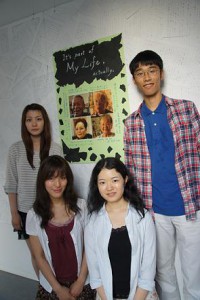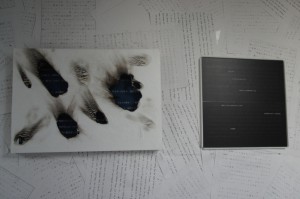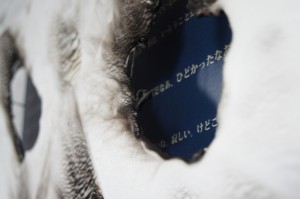JPN
EN
投稿日:2013年1月9日
カテゴリー: 平和のために東大生ができること
Hello, I’m Asako. I’m a sophomore student and have joined this seminar since this semester.
Last Christmas, our seminar had an amazing experience with members from Ministry of Foreing Affairs.
They kindly gave us opportunity to introduce what our seminar is about and our achievement so far through last three semesters.
Let me introduce about last summer’s semester. Overall, we translated an UN document, “Disarmament: A Basic Guide”.
Well, merely translating english documents into Japanese! How boring, you might think. Actually, there’s a lot more in it.
First, reading the document itself helped us gain basic knowledge on disarmament. Since none of us is majoring in peace studies, this step was indispensable.
Secondly, we had to face technical terms, and to comprpehend them we were required extra-study on it.
Of course we did not end up simply translating it. Each has done researches according to their own interests.
This is a brief intruduction of our last summers seminar.
We also held two presentations in front of the members of the Ministry, they exposed us with questions , there took place lively discussions,
I can tell it was definetely a stimulating experience for us.
Since our seminar is now known to the Ministry and also to UN, we’ll keep it up much harder.
Announcement: Meetings to exchange opinions on peace and disarmament with foreign students
投稿日:2012年6月1日
カテゴリー: 平和のために東大生ができること
Hi, I’m Seiwa Honda, a sophomore student in University of Tokyo. In June, we held meetings to exchange opinions on peace and disarmament with foreign students. Brief Summary is following.
We belong to a seminar called ” What we can do for peace as students in University of Tokyo.” Discussing peace and disarmament in classes, we came to want to know how foreign students, who have been brought up in various countries and surroundings, think peace, war and disarmament. This is the aim for this exchange of opinions.You don’t need to have special experience or knowledge about war. All you need is passion for peace!
@Date: July 11(Mon.), 13(Wed.), 14(Thu.), 15(Fri.) each day starts at 18:30
You can come any day and any time!
@Gathering Spot: University of Tokyo Komaba Campus the main gate
(Move to a classroom after everyone gathers.)
@How can you take part in?
You just send an e-mail at peace2012@komex.c.u-tokyo.ac.jp
Please inform of name, birth, the day you want to participate in, e-mail address or phone number.
Subject line must be ” Attendance at exchange of Opinions”!
We hope many people come to this meeting and talk about peace!
Hi, I’m Hijiri Tomiyama.
As my friends explained already, we held the exibition of Hibakushas’ testimonies at the University of Tokyo.
Our group wanted to show Hibakushas’
a kind of philosophical views of their experiences through this work. So we tried to choose pictures which express their cheerful faces and phrases which quote their positive statements.
 There are those who hate the war or the atomic bomb itself , and those who hate the Japan and America because of their mistakes , and many of them tell that they are distressed by a feeling of guilt about their survival.In fact,we don’t experience the atomic bomb , so we can only image their physical and mental pain and feel so sorry. Their conflicts are too complicated for us to understand completely. They are tormented by the fact that even though a lot of their family and friends died , they still survive. They say “we were lucky enough”.
However , in spite of their hard experiences , they have to get over it and continue to live in this world. One of Hibakushas’ said that “It’s part of my life , actually”. We cannot and don’t want to believe that such a cruel event was real , but for them , it was a crucial part of their life . But it seems that they are accepting their experience as reality for me. When we heard their testimonies , we feel not only their grief but also their strength from their attitude.
Thank you for your reading.
There are those who hate the war or the atomic bomb itself , and those who hate the Japan and America because of their mistakes , and many of them tell that they are distressed by a feeling of guilt about their survival.In fact,we don’t experience the atomic bomb , so we can only image their physical and mental pain and feel so sorry. Their conflicts are too complicated for us to understand completely. They are tormented by the fact that even though a lot of their family and friends died , they still survive. They say “we were lucky enough”.
However , in spite of their hard experiences , they have to get over it and continue to live in this world. One of Hibakushas’ said that “It’s part of my life , actually”. We cannot and don’t want to believe that such a cruel event was real , but for them , it was a crucial part of their life . But it seems that they are accepting their experience as reality for me. When we heard their testimonies , we feel not only their grief but also their strength from their attitude.
Thank you for your reading.
 There are those who hate the war or the atomic bomb itself , and those who hate the Japan and America because of their mistakes , and many of them tell that they are distressed by a feeling of guilt about their survival.In fact,we don’t experience the atomic bomb , so we can only image their physical and mental pain and feel so sorry. Their conflicts are too complicated for us to understand completely. They are tormented by the fact that even though a lot of their family and friends died , they still survive. They say “we were lucky enough”.
However , in spite of their hard experiences , they have to get over it and continue to live in this world. One of Hibakushas’ said that “It’s part of my life , actually”. We cannot and don’t want to believe that such a cruel event was real , but for them , it was a crucial part of their life . But it seems that they are accepting their experience as reality for me. When we heard their testimonies , we feel not only their grief but also their strength from their attitude.
Thank you for your reading.
There are those who hate the war or the atomic bomb itself , and those who hate the Japan and America because of their mistakes , and many of them tell that they are distressed by a feeling of guilt about their survival.In fact,we don’t experience the atomic bomb , so we can only image their physical and mental pain and feel so sorry. Their conflicts are too complicated for us to understand completely. They are tormented by the fact that even though a lot of their family and friends died , they still survive. They say “we were lucky enough”.
However , in spite of their hard experiences , they have to get over it and continue to live in this world. One of Hibakushas’ said that “It’s part of my life , actually”. We cannot and don’t want to believe that such a cruel event was real , but for them , it was a crucial part of their life . But it seems that they are accepting their experience as reality for me. When we heard their testimonies , we feel not only their grief but also their strength from their attitude.
Thank you for your reading.
Hi I’m Mizuki, a second-year student of the University of Tokyo. I’m going to write a short description of the works of my group in this article.
 Many survivors of nuclear bombing say “it’s couldn’t be understood by a person didn’t experience.” How we should face this distance.
The upper statement is English translation of what we made as an introduction of our works when we exhibit them. This is the most important point of it and that’s all. I do not want to discuss in detail it in this article, and also I do not think I could. We can argue that this sense of impossibility was the very motive to make these works.
The work in the left named “Yakeato” is made of two form board. One is printed with an experience of a survivor and put behind, and another is put in front of the board with experience. The front board was melted by roasting and has many holes.
Many survivors of nuclear bombing say “it’s couldn’t be understood by a person didn’t experience.” How we should face this distance.
The upper statement is English translation of what we made as an introduction of our works when we exhibit them. This is the most important point of it and that’s all. I do not want to discuss in detail it in this article, and also I do not think I could. We can argue that this sense of impossibility was the very motive to make these works.
The work in the left named “Yakeato” is made of two form board. One is printed with an experience of a survivor and put behind, and another is put in front of the board with experience. The front board was melted by roasting and has many holes.
 The work in the right named “Zanshi” is made of one board. It’s also printed with an experience of another survivor. However, the letters are extremely pale so that you cannot read them without coming close almost touching it.
We do not intend to insist one just explication, of cause. We want to depict the complexity and diversity which we cannot describe definitely but exist certainly.
Thank you for your reading.
M.U.
The work in the right named “Zanshi” is made of one board. It’s also printed with an experience of another survivor. However, the letters are extremely pale so that you cannot read them without coming close almost touching it.
We do not intend to insist one just explication, of cause. We want to depict the complexity and diversity which we cannot describe definitely but exist certainly.
Thank you for your reading.
M.U.
 Many survivors of nuclear bombing say “it’s couldn’t be understood by a person didn’t experience.” How we should face this distance.
The upper statement is English translation of what we made as an introduction of our works when we exhibit them. This is the most important point of it and that’s all. I do not want to discuss in detail it in this article, and also I do not think I could. We can argue that this sense of impossibility was the very motive to make these works.
The work in the left named “Yakeato” is made of two form board. One is printed with an experience of a survivor and put behind, and another is put in front of the board with experience. The front board was melted by roasting and has many holes.
Many survivors of nuclear bombing say “it’s couldn’t be understood by a person didn’t experience.” How we should face this distance.
The upper statement is English translation of what we made as an introduction of our works when we exhibit them. This is the most important point of it and that’s all. I do not want to discuss in detail it in this article, and also I do not think I could. We can argue that this sense of impossibility was the very motive to make these works.
The work in the left named “Yakeato” is made of two form board. One is printed with an experience of a survivor and put behind, and another is put in front of the board with experience. The front board was melted by roasting and has many holes.
 The work in the right named “Zanshi” is made of one board. It’s also printed with an experience of another survivor. However, the letters are extremely pale so that you cannot read them without coming close almost touching it.
We do not intend to insist one just explication, of cause. We want to depict the complexity and diversity which we cannot describe definitely but exist certainly.
Thank you for your reading.
M.U.
The work in the right named “Zanshi” is made of one board. It’s also printed with an experience of another survivor. However, the letters are extremely pale so that you cannot read them without coming close almost touching it.
We do not intend to insist one just explication, of cause. We want to depict the complexity and diversity which we cannot describe definitely but exist certainly.
Thank you for your reading.
M.U.

